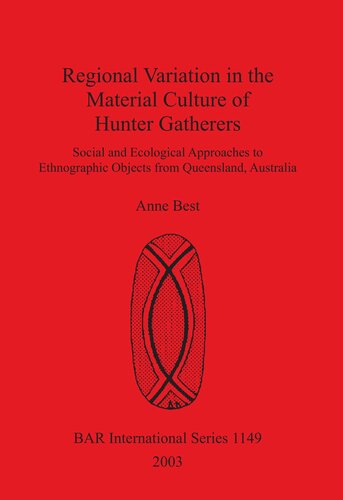

Most ebook files are in PDF format, so you can easily read them using various software such as Foxit Reader or directly on the Google Chrome browser.
Some ebook files are released by publishers in other formats such as .awz, .mobi, .epub, .fb2, etc. You may need to install specific software to read these formats on mobile/PC, such as Calibre.
Please read the tutorial at this link: https://ebookbell.com/faq
We offer FREE conversion to the popular formats you request; however, this may take some time. Therefore, right after payment, please email us, and we will try to provide the service as quickly as possible.
For some exceptional file formats or broken links (if any), please refrain from opening any disputes. Instead, email us first, and we will try to assist within a maximum of 6 hours.
EbookBell Team

5.0
78 reviewsThe author's concern in this volume is the spatial organisation of hunters and gatherers and how this is manifested through dissimilarities in the style of objects. Differences were tested in Queensland Aboriginal material culture, aiming to search for a regionalisation of style. The study is broad-scale and the results show a clear regionalisation in Queensland that broadly correlates with drainage divisions: the patterns are robust. The model presented is applicable to archaeological research which is concerned with distributions of style and how these are associated with the populations of past hunters and gatherers. The primary data are 813 artefacts (including bags, boomerangs, message sticks, shields, spears and spearthrowers) from selected UK and Australian museum collections. The objects date from the early contact period and were collected by explorers, colonial officials and anthropologists. Secondary sources include published and unpublished material, archaeology, rock art, early photographs and present-day Aboriginal spokesmen. Analysis of the data proceeds from the most broad-based presence/absence evidence and continues to examine and compare the morphological characteristics of the objects. At each stage, the findings are set against the regional model, whereby Queensland in divided into six geographical regions based on drainage divisions. The findings are considered against social and environmental models of style. The author evaluates the impact that ecology plays on stylistic traditionand discusses the social role of style as a means of transmitting social information. She also considers the 'open' and 'closed' model which, in a hunter-gatherer context, has been linked to environmental conditions. The conclusions of the analyses suggest that both environmental and social factors play an important part in stylistic tradition and stylistic choice.